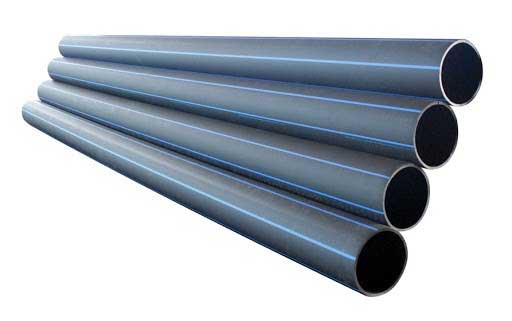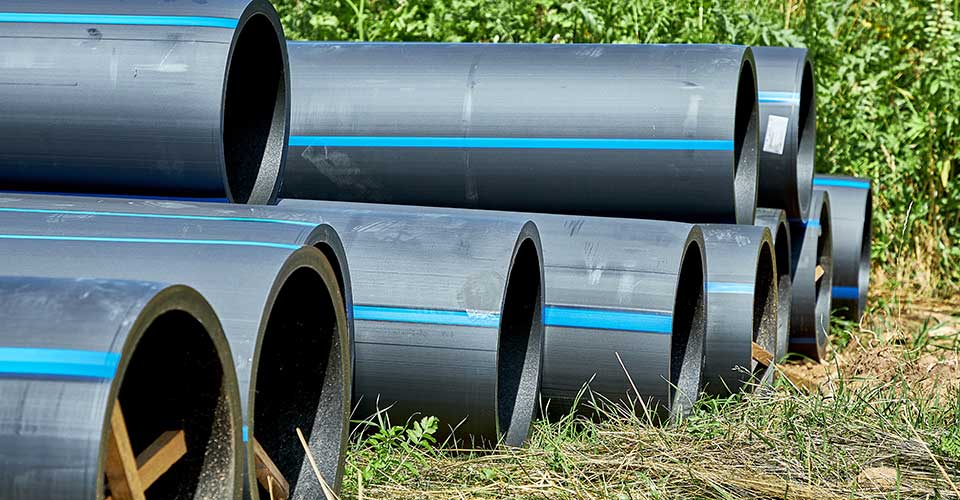Where to Find hdpe pipe in stock Midland TX for Urgent Projects
Wiki Article
Explore the Manufacturing Refine Behind High-Quality HDPE Pipe and Its Applications
The manufacturing procedure of high-grade HDPE pipelines is detailed and systematic. It starts with the selection of basic materials that enhance performance. Following this, ethylene goes through polymerization to create resin, which is then shaped through extrusion. Quality control is paramount, guaranteeing that the end product fulfills strict standards. The journey of HDPE pipes does not finish with manufacturing. Their applications throughout different industries expose a more comprehensive importance worth taking a look at.Comprehending HDPE: Residences and Advantages

High-density polyethylene (HDPE) is a functional polycarbonate recognized for its sturdiness and resistance to numerous environmental factors. This material displays outstanding tensile toughness, making it ideal for requiring applications. Its low-density framework contributes to a light-weight item, assisting in ease of dealing with and setup. HDPE also showcases remarkable resistance to chemicals, which reduces deterioration when subjected to harsh materials.
The product's low dampness absorption even more boosts its longevity, making it perfect for use in pipelines and tank. Furthermore, HDPE is resistant to ultraviolet (UV) radiation, making certain that products keep their honesty also when subjected to sunlight. In addition, its adaptability permits the creation of detailed shapes without compromising strength. The environmentally friendly nature of HDPE, often stemmed from recycled materials, adds to its appeal, advertising lasting techniques in production. In general, these residential properties and advantages make HDPE a recommended option for numerous commercial and consumer applications.
Basic Material Selection for HDPE Manufacturing
The choice of basic materials for HDPE production is necessary to confirm the final product satisfies the preferred specifications and top quality requirements. High-density polyethylene (HDPE) is largely created from polymerized ethylene, acquired from fossil fuels such as gas or unrefined oil. The high quality of these feedstocks significantly affects the mechanical and thermal properties of the last HDPE.Ingredients additionally play a substantial duty in boosting HDPE's performance, consisting of antioxidants, UV stabilizers, and colorants, which enhance resilience and resistance to environmental variables. The option process should think about not only the chemical structure of the raw products however also their processing features to assure efficient production.
The sourcing of raw products must prioritize sustainability and compliance with ecological policies, as responsible techniques are important in today's market. Inevitably, careful raw product option lays the foundation for producing high-quality HDPE pipes ideal for varied applications.
The Extrusion Process: Shaping HDPE Pipe
The extrusion procedure plays a crucial duty fit HDPE pipes, starting with meticulous product prep work methods that guarantee perfect circulation and uniformity. Equally essential is the layout of the die, which directly affects the final dimensions and surface area quality of the pipe. With each other, these variables contribute substantially to the performance and top quality of HDPE pipeline production.Product Preparation Methods
Efficient manufacturing of HDPE pipes begins with meticulous product prep work strategies, especially the extrusion process. During this phase, high-density polyethylene material is very first dried to remove moisture, ensuring suitable flow characteristics. The resin is after that fed into the extruder, where it undertakes heating and melting, transforming right into a viscous state. This heating procedure is very carefully regulated to keep the material's integrity and performance. The liquified HDPE is required with a die, shaping it into a continual pipeline type. Correct temperature monitoring throughout extrusion is important, as it straight influences the material's residential properties and the end product high quality. Once shaped, the HDPE pipe is cooled down and reduced to specified sizes, all set for subsequent handling and applications.Die Style Importance
Precision in die style plays a crucial duty in the extrusion process of HDPE pipes. The die acts as the final shaping tool, directly influencing the pipeline's measurements, wall density, and surface area coating. A well-designed die warranties uniform product circulation, reducing defects such as abnormalities and vulnerable points. The geometry of the die should be optimized to fit the particular homes of HDPE, including its thickness and thermal behavior throughout extrusion. Additionally, the cooling price of the material as it travels through the die can significantly affect the pipeline's architectural stability. Spending in sophisticated die technology is crucial for manufacturers aiming to generate top notch HDPE pipes that fulfill sector standards and customer expectations.Quality Control Procedures in HDPE Production
Various aspects influence the high quality of HDPE pipe production, effective quality control procedures are important to ensure consistency and dependability in the last item (Midland TX HDPE Pipe Fittings in Stock). Trick quality assurance methods consist of strenuous material evaluation, confirming that the raw polyethylene meets well-known standards for purity and density. Throughout the extrusion process, parameters such as temperature level, stress, and cooling time are carefully monitored more info to maintain dimensional precision and architectural honestyAdditionally, post-production screening is vital; producers usually carry out hydrostatic tests to evaluate the pipeline's stamina and resistance to stress. Visual inspections for surface problems further improve quality control. Qualification from pertinent standards organizations, like ASTM or ISO, supplies an extra layer of integrity. By applying these detailed quality assurance steps, makers can minimize defects, enhance performance, and make sure that the HDPE pipes fulfill the details demands of different applications, ultimately causing consumer complete satisfaction and count on the product.
Applications of HDPE Pipeline Throughout Industries
HDPE pipelines are made use of throughout different industries due to their longevity and convenience. In water circulation systems, they assure effective distribution, while in wastewater administration, they supply trustworthy options for waste transportation. Furthermore, farming watering networks take advantage of HDPE's resistance to rust and adaptability, making it a suitable selection for modern-day farming techniques.
Water Distribution Systems
A significant number of sectors rely upon high-density polyethylene (HDPE) pipelines for reliable water circulation systems. Known for their durability and resistance to rust, HDPE pipelines are extensively used in local supply of water networks, farming irrigation, and commercial applications. Their light-weight nature helps with easy handling and installment, minimizing labor costs and time. Furthermore, HDPE pipelines can accommodate numerous stress levels, making them ideal for both low and high-pressure systems. Texas hdpe pipe manufacturer. The adaptability of the material permits seamless combination into existing framework, lessening the requirement for considerable excavation. Additionally, HDPE's resistance to chemical leaching assurances that the water provided remains risk-free and tidy, making it an optimal selection for keeping the high quality of drinkable water throughout different industriesWastewater Management Solutions
Reliable water circulation systems likewise lead the way for ingenious wastewater management services, where high-density polyethylene (HDPE) pipelines play a substantial duty. Prominent for their longevity and resistance to rust, HDPE pipelines are suitable for moving wastewater in various settings. Their flexibility enables very easy installation in intricate settings, reducing the need for extensive excavation. Furthermore, HDPE's smooth indoor surface area minimizes rubbing, improving circulation rates and performance. These pipelines are also immune to chemical leaching, making certain that pollutants do not compromise the surrounding atmosphere. Industries, towns, and treatment facilities significantly rely on HDPE pipelines for their integrity and durability, making them a preferred selection for contemporary wastewater monitoring systems. This adaptability emphasizes the vital significance of HDPE pipelines across numerous applications.Agricultural Watering Networks
Agricultural irrigation networks benefit considerably from using high-density polyethylene (HDPE) pipes, which provide efficient and dependable water shipment to plants. HDPE pipes are lightweight, making them simple to carry and install, while their flexibility permits various configurations in diverse surfaces. These pipelines show exceptional resistance to corrosion, chemicals, and UV radiation, making sure toughness in harsh farming settings. Furthermore, their smooth indoor surface reduces rubbing loss, enhancing water circulation and decreasing energy prices connected with pumping. The durability of HDPE pipes, commonly going beyond half a century, adds to lower upkeep and substitute expenses. Farmers progressively depend on HDPE pipelines to improve irrigation performance and advertise lasting farming techniques, eventually leading to improved crop returns and resource conservation.
Future Trends in HDPE Pipe Technology
As the need for sustainable and effective infrastructure expands, innovations in HDPE pipeline modern technology are positioned to change numerous markets. Arising trends consist of the combination of smart innovations, such as sensors and IoT capabilities, which assist in real-time tracking of pipe problems, reducing maintenance expenses and stopping leaks. In addition, the development of sophisticated production strategies, such as 3D printing, is making it possible for the production of complicated, customized pipe designs that satisfy particular job requirements.The focus on recycling and round economy techniques is driving the innovation of HDPE pipelines made from recycled products, improving sustainability. Improved jointing approaches, such as electro-fusion and mechanical installations, are additionally enhancing installment effectiveness and dependability. The growing focus on ecological policies is pushing manufacturers to adopt greener production processes, making certain that HDPE pipes not only meet market requirements but additionally foster an even more lasting future for facilities growth.
Often Asked Inquiries
How Does HDPE Contrast to Other Plastic Materials?
HDPE outperforms many other plastic materials regarding toughness, chemical resistance, and flexibility. Its low density and high tensile strength make it optimal for various applications, typically surpassing alternatives in both efficiency and longevity.What Are the Ecological Influences of HDPE Manufacturing?
The ecological impacts of HDPE manufacturing consist of greenhouse gas discharges, energy intake, and potential air pollution from producing procedures. Additionally, inappropriate disposal can result in dirt and water contamination, increasing worries regarding lasting ecological impacts.Can HDPE Water Lines Be Recycled?
Yes, HDPE pipes can be reused. Numerous centers accept used HDPE for processing, transforming it into brand-new items. This reusing contributes to sustainability efforts, decreasing plastic waste while preserving sources and energy in the production cycle.What Is the Lifespan of HDPE Water Lines?

Exactly How Do Temperature Variations Influence HDPE Pipeline Performance?
Temperature variants greatly affect HDPE pipeline performance, influencing flexibility and strength. Heats can result in softening, while reduced temperature levels may cause brittleness, inevitably influencing the pipeline's sturdiness and viability for various applications in varied settings.Report this wiki page